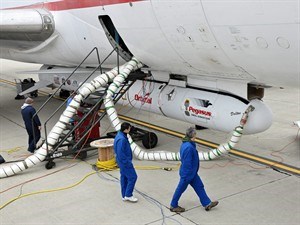
This undated photo provided by NASA shows the Orbital Sciences Corporation Pegasus XL rocket with the NuSTAR spacecraft after attachment to the L-1011 carrier aircraft known as "Stargazer." The Pegasus will launch NuSTAR into space, Wednesday June 13, 2012 where the high-energy X-ray telescope will conduct a census for black holes, map radioactive material in young supernovae remnants, and study the origins of cosmic rays and extreme physics around collapsed stars. (AP Photo/NASA, Randy Beaudoin)
June 13, 2012 - 4:27 AM
LOS ANGELES, Calif. - NASA is poised to launch its latest X-ray space telescope on a two-year hunt for hard-to-see objects lurking in the heart of the Milky Way and other galaxies.
The telescope was perched atop a rocket at a remote Pacific island launch site. On Wednesday, a carrier aircraft with the Pegasus XL rocket strapped underneath will take off from the Kwajalein Atoll, a horseshoe-shaped island halfway between Hawaii and Australia.
At 40,000 feet, the aircraft will release the rocket, which will free-fall for several seconds before igniting its engines for the climb to space. If all goes as planned, the refrigerator-size telescope will separate from the rocket and unfurl its solar panels once in orbit about 350 miles above Earth.
The Nuclear Spectroscopic Telescope Array, or NuStar for short, focuses high-energy X-rays to peer through gas and dust in search of supermassive black holes in the centre of galaxies, remnants of exploded stars and other exotic celestial objects.
While black holes are invisible, the region around them gives off telltale X-rays. NuStar will observe previously known black holes and map hidden ones. By shining a light on never-before-seen parts of the universe, scientists hope to better understand how galaxies form and evolve.
"We can view black holes and galaxies even if they're enshrouded with dust and gas. If you had high-energy X-ray eyes and you stared up out of the galaxy, what you would see is the glow of all the massive black holes sprinkled throughout the cosmos," chief scientist Fiona Harrison of the California Institute of Technology said earlier this week.
NuStar will also hunt for the remains of ancient supernovae, stars that exploded in past centuries. If it's lucky, it'll witness a star's death throes, but such events don't happen often and the telescope will have to be pointed in the right place at the right time.
Scientists expect sharp images from the mission, which is many times more sensitive than previous space telescopes that have looked in this part of the electromagnetic spectrum.
After a week in orbit, NuStar will extend its 33-foot mast laden with sensors. Observations will begin about a month after launch.
The $170 million mission was supposed to lift off in March, but was delayed by a flight software issue with the rocket. To keep costs down, project managers decided to air-launch the telescope into space instead of blasting off from the launch pad, which would have required a much larger rocket.
The launch comes at a trying time for NASA's astrophysics division. Last week, the space agency killed an X-ray telescope mission because it failed to come in on budget. That mission called GEMS was supposed to launch in 2014 and would have observed many of the same targets as NuStar.
NASA is pressing ahead with its flagship astrophysics mission — the budget-busting James Webb Space Telescope considered the successor to the Hubble Space Telescope with the capability of peering deeper into the universe and back in time than ever. It's now expected to launch in 2018 at an $8 billion price tag.
___
Follow Alicia Chang's coverage at http://www.twitter.com/SciWriAlicia
News from © The Associated Press, 2012